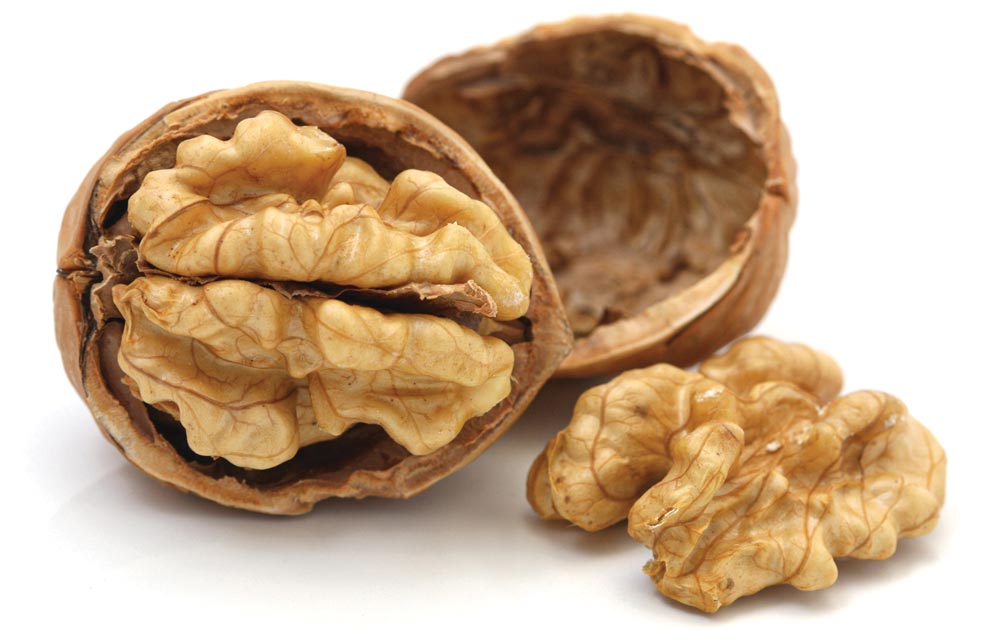Walnuts Are Worth the Work!
Their shells are tough, but their nutrition and other benefits are hard to beat.
Name: Black Walnut
(Juglans spp.)
Description
The black walnut is a member of the walnut family (Juglandaceae). The walnut is found all over North America and is often called the “black walnut” when referring to the wild walnut. There are 21 species of Juglans worldwide, including the English walnut (J. regia), which has been planted in farms and yards or is surviving around old farms.
The walnut is a full-bodied, native, deciduous tree with pinnately divided leaves that typically reaches 70 to 80 feet in height and a diameter of 2 to 4 feet. There are typically from 11 to 19 leaflets per leaf.

Their nuts have a soft, green outer layer, which turns black as it matures and has long been used as a dye. Wild walnut shells require a rock or a hammer to crack. The meat in the black walnut is oily and delicious, although there’s not as much meat as you’d find in the cultivated English walnut.
Where Found
Walnuts, both wild and cultivated, are common in North America in mountains, canyons and open fields.
Uses
Both wild and cultivated walnuts drop from the trees each autumn. You can eat wild black walnuts as a snack and use them in any recipes the same way you’d use the English walnut.
Walnut meat was widely used by all the Native American tribes that had access to it. Sometimes, it was mixed with other seeds and berries to make a type of bread. The nutmeats were added to various soups, such as corn soup. Sometimes, the nutmeats were crushed and boiled, and the oil was allowed to come to the top of the pot. It was then used in various recipes.
The wood from walnut trees is used to make furniture and is well-known as a component of gun stocks.

Processing
You’ll need to crack open the wild walnuts with a rock or hammer. If you crack the shell from the top, you’re more likely to get an even split, which will make it easier to extract the meat. Even then, a nut pick would be handy for separating out the shell from the meat. It could take awhile to get enough walnuts for a cake, a batch of cookies or other dessert items.
When to Harvest/Availability
Walnuts begin to drop from the trees in the fall and should be collected so they’re not eaten by animals or get moldy. Once collected, the husks can be removed or allowed to dry.
When dried, walnuts will keep for months, so you can enjoy them throughout the year. They can be kept in their shells until you’re ready to use them. Alternatively, you can shell them and store the meat in sealed containers.

Medicine/Nutrition
Of the eight most nutritious nuts, walnuts top the list! They contain omega-3 alpha-linolenic acid, which makes them good for your brain’s health. They’ve also been shown to be good for your heart and vascular function. Eating walnuts is also good for improving your immune system. They’re rich in antioxidants and are healthy in many other ways (you can read about the 13 proven health benefits of eating walnuts at www.Healthline.com/nutrition/benefits-of-walnuts).
According to the USDA, 100 grams of shelled black walnuts contain 570 mg of phosphorus, 460 mg of potassium and 300 mg of vitamin A.
Advice for Growing
Walnut trees are readily available from native plant and regular nurseries. You can also try growing one from seed. Collect the seed in autumn and simply plant it in the ground or in a large pot.

Cautions
As the nuts begin their development, they’re covered with a green outer layer. This layer matures into a mushy texture and turns black. As mentioned, the black outer layer is also a very good dye, so you should wear gloves if you’re collecting the nuts while the outer layer is still “wet” (or simply wait and then collect the walnuts after they’ve dried).
Other Uses
Indigenous people crushed and then tossed the green, immature black walnuts into pools of water to stun the fish. Then, the fish would be scooped out by hand or with nets. However, this might be illegal in your area, so check with local authorities before you attempt it.
The black dye from the walnut husk has long been used for writing ink and for artist’s paint.

Recipes
Besides eating them out of hand, chopped walnuts are great added to cakes and other baked goods and as a topping for ice cream.
Also try mixing a half-cup of chopped walnuts into pancake or bread batter to add some flavor, texture and to bump up the nutritional value.
About ASG’s Plant Advisor
Christopher Nyerges has been teaching ethnobotany since 1974. He is the author of Guide to Wild Foods and Useful Plants, Foraging Wild Edible Plants of North America and other books on the uses of wild plants. He can be reached at SchoolofSelf-Reliance.com.
Editor’s note: A version of this article first appeared in the March, 2021 print issue of American Survival Guide.




